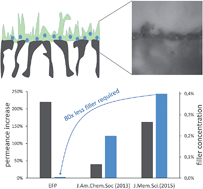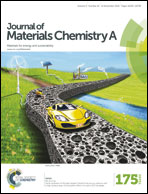Controlled positioning of MOFs in interfacially polymerized thin-film nanocomposites†
Abstract
An advanced synthesis protocol for the preparation of Thin-Film Nanocomposite (TFN) membranes is presented. The Evaporation-controlled Filler Positioning (EFP) method carefully pre-positions the filler (ZIF-8 nanoparticles) exactly at the water/solvent interface before the initiation of the interfacial polymerization. A permeance increase of 220% compared to the counterpart without filler is observed, corresponding to the highest ever reported permeance increase upon filler incorporation for MOF-based TFN membranes without rejection loss. Moreover, optimal membrane performance is already obtained at a MOF concentration as low as 0.005 w/v%, which represents an 80 times reduction in the required amount of filler compared to other reported ZIF-8 based TFN membranes. This explicitly proves the importance of pre-positioning the filler right where it is needed, i.e. at the organic/water interface, before the interfacial polymerization. ZIF-8 based TFN membranes are prepared via both the EFP and the conventional synthesis method and a comparison between both protocols was made. Additionally, the influence of the size of the filler is investigated. All prepared membranes are further characterized using SEM, TEM, ATR-FTIR and XPS. The EFP-method is found to lead to better and more reproducible filtration performances.


 Please wait while we load your content...
Please wait while we load your content...